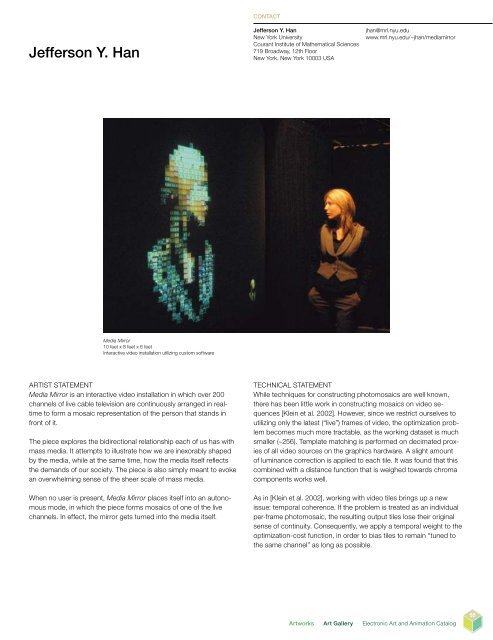Intersections - Nguyen Dang Binh
Intersections - Nguyen Dang Binh
Intersections - Nguyen Dang Binh
Create successful ePaper yourself
Turn your PDF publications into a flip-book with our unique Google optimized e-Paper software.
Jefferson Y. Han<br />
Media Mirror<br />
10 feet x 8 feet x 6 feet<br />
Interactive video installation utilizing custom software<br />
ARTIST STATEMENT<br />
Media Mirror is an interactive video installation in which over 200<br />
channels of live cable television are continuously arranged in realtime<br />
to form a mosaic representation of the person that stands in<br />
front of it.<br />
The piece explores the bidirectional relationship each of us has with<br />
mass media. It attempts to illustrate how we are inexorably shaped<br />
by the media, while at the same time, how the media itself reflects<br />
the demands of our society. The piece is also simply meant to evoke<br />
an overwhelming sense of the sheer scale of mass media.<br />
When no user is present, Media Mirror places itself into an autonomous<br />
mode, in which the piece forms mosaics of one of the live<br />
channels. In effect, the mirror gets turned into the media itself.<br />
CONTACT<br />
Jefferson Y. Han<br />
New York University<br />
Courant Institute of Mathematical Sciences<br />
719 Broadway, 12th Floor<br />
New York, New York 10003 USA<br />
jhan@mrl.nyu.edu<br />
www.mrl.nyu.edu/~jhan/mediamirror<br />
TECHNICAl STATEMENT<br />
While techniques for constructing photomosaics are well known,<br />
there has been little work in constructing mosaics on video sequences<br />
[Klein et al. 2002]. However, since we restrict ourselves to<br />
utilizing only the latest (“live”) frames of video, the optimization problem<br />
becomes much more tractable, as the working dataset is much<br />
smaller (~256). Template matching is performed on decimated proxies<br />
of all video sources on the graphics hardware. A slight amount<br />
of luminance correction is applied to each tile. It was found that this<br />
combined with a distance function that is weighed towards chroma<br />
components works well.<br />
As in [Klein et al. 2002], working with video tiles brings up a new<br />
issue: temporal coherence. If the problem is treated as an individual<br />
per-frame photomosaic, the resulting output tiles lose their original<br />
sense of continuity. Consequently, we apply a temporal weight to the<br />
optimization-cost function, in order to bias tiles to remain “tuned to<br />
the same channel” as long as possible.<br />
Artworks Art Gallery Electronic Art and Animation Catalog<br />
55

















